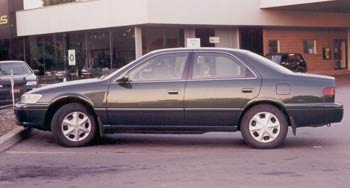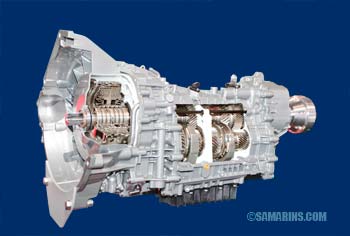Signs of automatic transmission problems when test driving a used car
Updated: June 19, 2022
Many of us buy used cars to save money, but how can you avoid buying a Lemon with a bad transmission? Transmission repairs are costly. Years back, we were shopping for a used car and found this clean 5-year old Toyota Camry on a local car lot.
 Good car or Lemon?
Good car or Lemon?Before making the final decision, we asked for another test drive. We took the car on the highway and when returning through city streets, we noticed that after 20 minutes, the transmission started slipping. That's why the price was so low!
The transmission is the second major component of the car (the engine is the first) that will cost thousands to replace if it fails.
Repairing a modern transmission is not an easy task as they are becoming more and more complex.
Despite technological advancement, transmission troubles are still common in many cars. That's why it's so important to watch out for early signs of transmission problems when test driving a used car. What are they?
Signs of automatic transmission problems:
Delayed engagement. There was a Ford Ranger that we came to check early on a cold winter morning. It started well, but when shifted into Reverse, it took 5-6 seconds before the transmission finally felt engaged. It's an early sign that the transmission is on its way, even though it might work well once warmed up.Slipping. In some cars you may feel slipping when accelerating from a stop. For example, when you shift in Drive and accelerate but the vehicle doesn't move, or starts moving after a delay. Sometimes slipping is felt in one of the higher gears when the transmission shifts normally in low gears, but in some of the higher gears feels like going into neutral.
Strong Jolt/Clunk when shifted into Drive or Reverse. For example, it is a common early sign of transmission troubles in some older Hondas. In some cars, the jolt may be felt when coming to a stop.
Loss of power/acceleration after driving for a while. For example, in some Nissan vehicles, the continuously variable transmission (CVT) can overheat and go into a limp mode with reduced power.
Harsh shifting between gears. We test drove the BMW X5 that was in a like-new condition, but it had one problem: the transmission shifted from 4-th to 5-th gear with a strong jolt. Even though all other shifts were smooth, we passed on that vehicle, as it will be costly to repair.
Jerking/Shuddering. These symptoms are common in some failing CVTs transmissions and can be felt during acceleration or deceleration. In some vehicles with dual-clutch transmission (e.g., Ford PowerShift), jerking when accelerating slowly from a stop can be a sign of oil leaking onto the clutch discs.
Fluctuating RPMs when driving steady. Some CVTs when worn out may feel like hunting for the right gear. You might notice that the engine RPMs are going up and down when driving at a steady speed.
Irregular noises. One of our friends had a Jeep Patriot that had a humming noise while driving. It tuned out that the noise was coming from the transmission. It was too expensive to repair, so our friend has opted to trade it for another car.
Some transmissions (e.g., CVTs) might produce loud whining or whirring noises when worn out. If in doubt, we'd recommend test-driving another car of the same make and model to compare.
Dirty transmission fluid with a burnt smell. Many modern cars don't have a transmission fluid dipstick, but if the vehicle you want to buy has one, it's a good idea to check the condition of the transmission fluid on the dipstick. The Owner's Manual will have the instructions.
If the transmission fluid looks too dirty or has a burnt smell, the vehicle should be avoided. Many modern cars have a small hidden dipstick that your mechanic can check when inspecting the vehicle on a hoist.
Transmission fluid leaks or low transmission fluid level. Fluid leaks are not always visible, but when you take the car you want to buy for a pre-purchase inspection, you mechanic will be able to see them. Some of the leaks are not too difficult to repair, but if the transmission fluid level was low for a while, the transmission might be worn inside due to lack of fluid.
Check Engine or A/T warning light or "D" light blinking. Any warning light staying on or a warning message must be checked before buying a car or the vehicle should be avoided. In some cars, the Transmission Control Module or TCM is known to fail and it too is expensive to replace. Even the Check Engine light might come on due to a transmission fault.
How does a good transmission behave during a test drive?
A good transmission engages almost immediately when shifted into Drive or Reverse. The acceleration and shifts between gears are smooth. There are no excessive noises, vibration or jolts whether accelerating, costing, decelerating or coming to a stop.When shifting, the PRNDL indicator matches the gear the transmission is in. The transmission works consistently well whether the vehicle is just started or after prolonged drive.
Read Next:
Buying a Used Car: 10 Common Mistakes to Avoid
Pros and cons of turbo engines
Pros and cons of the CVT transmission
What mileage is OK for a used car?
How to inspect a used car - illustrated guide
Signs of a collision repair, rust or paint job when buying a used car
How to check an engine when buying a used car
What mileage is OK for a used car?
Reviews of popular used cars including problems to watch out for.
Reviews of popular used SUVs.
Buying a Used Car: 10 Common Mistakes to Avoid
Pros and cons of turbo engines
Pros and cons of the CVT transmission
What mileage is OK for a used car?
How to inspect a used car - illustrated guide
Signs of a collision repair, rust or paint job when buying a used car
How to check an engine when buying a used car
What mileage is OK for a used car?
Reviews of popular used cars including problems to watch out for.
Reviews of popular used SUVs.

